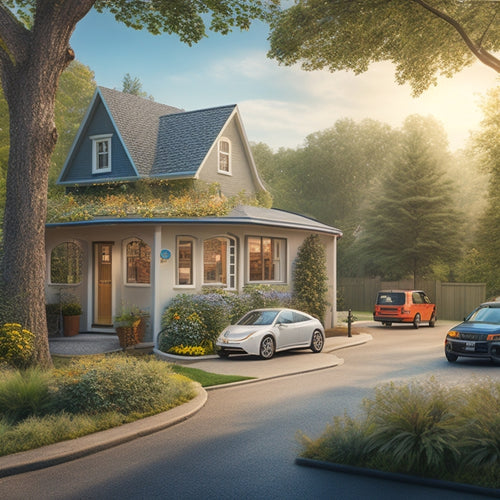
What Is the Cost of Solar Power Installation at Home
Share
You can expect to pay between $12,500 and $35,000 for a typical residential solar power installation at home, which can provide significant long-term savings on your electricity bills. The cost depends on the type and size of the system you choose, with more efficient monocrystalline panels costing more than polycrystalline ones. Federal and state incentives can reduce the upfront costs by up to 30%, and financing options like loans and power purchase agreements are available. As you consider making the switch to solar power, it's crucial to weigh these factors to get an accurate estimate of the costs involved and uncover how you can maximize your savings.
Key Takeaways
- The average cost of a residential solar system ranges from $15,000 to $30,000, with federal and state incentives reducing upfront costs by up to 30%.
- The cost of solar panels varies from $2.50 to $3.50 per watt, with a typical residential system requiring 5,000 to 10,000 watts.
- Installation expenses account for approximately 70% of the total cost, including purchasing and installing panels, inverters, and mounting hardware.
- Financing options, such as loans and power purchase agreements, can help reduce upfront costs, while long-term savings on electricity bills average $500 to $1,000 per year.
- Ongoing maintenance costs are minimal, with system monitoring ranging from $40 to $100 per year and occasional repair services costing between $100 and $500 per incident.
Understanding Solar Panel Costs
As you weigh the pros and cons of moving to solar energy, understanding the costs associated with solar panel installation is essential. The cost of solar panels varies depending on the type and quality of the equipment.
There are two main solar panel types: monocrystalline and polycrystalline. Monocrystalline panels are more efficient and expensive, while polycrystalline panels are less efficient but more affordable.
The average cost of solar panels ranges from $2.50 to $3.50 per watt. A typical residential solar panel system requires around 5,000 to 10,000 watts, resulting in a total cost of $12,500 to $35,000.
However, with federal and state incentives, you can reduce the upfront cost by up to 30%. Additionally, solar panels can help you save money on energy bills, with an average energy savings of $400 to $1,000 per year.
Factors Affecting Installation Prices
You've determined that solar panels are a viable option for your home, and now you're considering the installation process. As you move forward, it's vital to understand the factors that affect installation prices. One notable factor is the availability of incentive programs, which can greatly reduce the upfront cost.
You should also investigate financing options, such as loans or power purchase agreements, to make solar power more accessible.
The installation location is another important factor, as it impacts the system's performance and durability. For instance, installations in areas with high levels of shade or extreme weather conditions may require additional equipment, increasing the cost.
The system size and panel type also play a notable role in determining the installation price. Larger systems with high-efficiency panels will generally cost more than smaller systems with standard panels.
Additionally, local regulations, such as permits and inspections, can add to the overall cost. By understanding these factors, you can make informed decisions and optimize your solar power installation for maximum savings and efficiency.
Average Cost of Solar Systems
Reflecting on your decision to install solar power at home, it's vital to know the average cost of solar systems to plan your budget effectively. On average, a residential solar system costs between $15,000 and $30,000, depending on the system size and quality.
However, with solar incentives, you can greatly reduce this upfront cost. The federal solar investment tax credit (ITC) allows you to claim 26% of the total cost as a tax credit, bringing the cost down to around $11,000 to $22,000. Additionally, many states and utilities offer their own incentives, further reducing the cost.
You also have various financing options to take into account. You can opt for a cash purchase, solar loan, or power purchase agreement (PPA).
Whatever financing option you choose, it's important to factor in the long-term savings on your electricity bills and the increased value of your property. With the average American family saving around $500 to $1,000 per year on their electricity bills, going solar can be a smart investment for your home and wallet.
Breakdown of Installation Expenses
Roughly 70% of the total solar power installation cost goes towards the installation expenses themselves. This includes the cost of purchasing and installing the solar panels, inverters, mounting hardware, and other necessary equipment.
You'll also need to factor in labor costs, which can vary depending on the complexity of the installation and the location of your home.
When it comes to the breakdown of installation expenses, you can expect to pay around $2.50 to $3.50 per watt for the solar panels themselves. This means that a typical 5-kilowatt system would cost around $12,500 to $17,500.
Additionally, you'll need to take into account the cost of inverters, which can range from $1,000 to $3,000, and mounting hardware, which can cost around $2,000 to $5,000.
Fortunately, there are financing options and installation incentives available to help offset these costs. For example, the federal government offers a 30% tax credit for solar installations, and many states offer additional incentives.
Ongoing and Maintenance Costs
Most solar power systems require minimal maintenance, but they do come with some ongoing costs. You'll need to take into account these expenses when calculating the overall cost of owning a solar power system.
One of the primary ongoing costs is system monitoring, which typically ranges from $40 to $100 per year. This service guarantees your system is operating at peak efficiency and detects any potential issues before they become major problems.
Additionally, you may need to budget for occasional repair services, which can vary in cost depending on the type and complexity of the issue. On average, repair costs can range from $100 to $500 per incident.
However, many solar panel manufacturers offer warranties that cover repairs and replacements for a certain number of years, typically 25 years or more.
It's essential to factor these ongoing costs into your budget to confirm you're getting the most out of your solar power system.
Frequently Asked Questions
Can I Install Solar Panels on My Own to Save Money?
You're tempted to go solo, but beware: while DIY advantages like cost savings are alluring, installation challenges like electrical skill and rooftop subtleties can leave you in the dark, literally, and financially drained.
Do Solar Panels Work During Power Outages?
You'll stay powered during outages with a solar panel system, but only if you opt for grid independence. Otherwise, your solar panel efficiency will be limited, and you'll still be tied to the grid, leaving you in the dark when it matters most.
How Long Does It Take to Install a Solar Panel System?
You'll be surprised to know that 90% of solar installations are completed within 3-5 days! During this installation timeline, you'll witness a seamless process, where experts will assess your roof, install panels, and connect them to the grid, making you a proud owner of a renewable energy system.
Can I Add More Solar Panels to My Existing System Later?
You can upgrade your existing solar panel system by adding more panels, but guarantee system compatibility for a seamless solar panel expansion.
Are There Any Solar Panel Financing Options Available?
As you commence on this eco-friendly expedition, you'll find a plethora of solar panel financing options unfolding before you, offering a guiding light of hope: from solar loan options with flexible repayment terms to lease agreements that let you utilize the sun's power without upfront costs.
Related Posts
-

Why Choose Solar Car Battery Charging Systems?
You're switching to a cleaner, more sustainable transportation option by choosing solar car battery charging systems,...
-

Why Nearby EV Conversion Shops Matter to You
Having a nearby EV conversion shop means you'll experience the benefits of a more personalized, convenient, and susta...
-

10 Tips for Cleaner City Air With Scooters
By adopting a few simple habits, you can make a significant impact on reducing city air pollution with your scooter. ...


